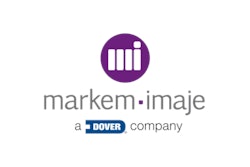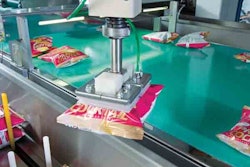For Cincinnati-based Sunny Delight Beverages Co., coding bottles of juice-based drinks was a messy business. The company was using continuous ink-jet coders to code bar codes, UPC codes, flavor designation, date, human readable information, and brand codes on a variety of its PET and HDPE bottles as well as its cases. The small-character ink-jet coders used on bottles were messy, causing ink to spill on the floor and conveyors. Furthermore, temperature fluctuations affected the density of the ink, which required the system to be recalibrated.
“Since our packing room isn’t air conditioned, we had huge temperature swings of 20 to 30 degrees,” explains Bart Bush, technology manager for Sunny Delight. “We would have to use make-up fluid to get the ink at the right density, and that would cause downtime.” During seasonal changes from summer to winter, the system was fine for several months, he says, but thereafter it had to be recalibrated three to four times a week, with each event lasting approximately 30 minutes.
The changes in ink density brought about by temperature fluctuations also caused ink to smudge, which resulted in illegible date codes on the bottles. According to Bush, this was one of the company’s most frequent consumer complaints. Sunny Delight also experienced problems with clogged jets at least once a day on its case coding systems. “You’d have to get a piece of wire and poke the jets to clean out the clogs,” he says.
Less mess, less downtime
To address its coding problems, the company decided to install three Markem (www.markem.com) 9096 small character ink-jet coders for its bottles and one 5000 Series 5400 case coder for printing on corrugated cases.
Markem’s Touch Dry hot-melt solid inks are solid at room temperature, so they won’t clog the machine or spill on machinery or floors. “There are no liquid solvents with the hot-melt ink-jet coders,” explains Ryan Petschel, Field Sales, Markem. “Your machines and coding area stay clean, and your operators appreciate a safer working environment. Replenishment of ink is done by simply inserting a block of solid ink into the machine without disruption to your coding process.” In addition, the ink dries immediately to the substrate, which helps to prevent smudging.
Coding takes place after the bottles are filled and capped. The company’s large line uses a GWS3/155 cold filler from Federal Mfg. Co. (www.federalmfg.com) and a Fowler/Zalkin capper from Fowler Products Co. (www.fowlerproducts.com). The company’s small line runs a Federal SWSS4 filler and a Federal monoblock GEM capper. Consolidated Container Co. (www.cccllc.com) supplies the HDPE bottles, and Graham Packaging (www.grahampackaging.com) provides the PET bottles.
Following filling and capping, the Markem 9096 codes 1-gal bottles at speeds of about 100 bottles/min and 64-oz bottles at speeds of 200 bottles/min on Sunny Delight’s large line. On the smaller line, two Markem 9096s code bottles ranging from 200 mL to 16 oz at speeds of 280 to 650 bottles/min.
After coding, bottles from the larger line are packed into cases using a Standard-Knapp (www.standardknapp.com) 935 packer, and cases are coded with the 5400 case coder, which runs approximately 35 cases/min. Cases are then sealed with a Standard-Knapp BHMS case sealer. Bottles from the smaller line are packed into trays and coded with an oil-based ink coder prior to being shrink-wrapped.
Bush estimates that the new Markem printers have saved the company two to three hours a week of downtime. “With the other systems, we had to intervene every day or every third day to recalibrate or clean the jets. These require attention maybe twice a year. We also no longer have ink all over the floor and conveyors,” he says. “That’s one of the things I really love about the wax-based ink.”





























